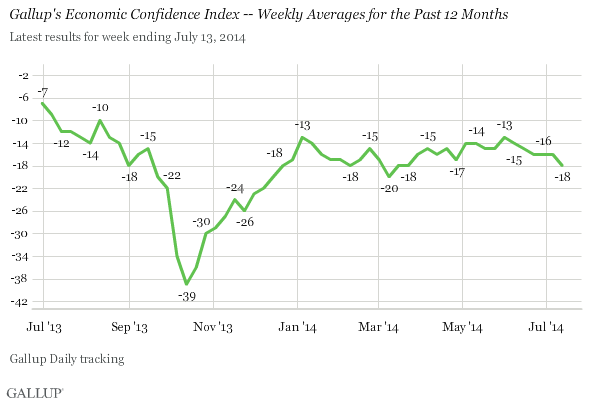WASHINGTON, D.C. -- Gallup's U.S. Economic Confidence Index dropped slightly to -18 last week, a level not seen since March. It registered at -16 for the three weeks prior, but had reached as high as -13 in early June.

Economic confidence has been mostly stable since the beginning of the year, staying within a seven-point margin and not moving by more than three points from week to week. It has reached a high of -13 twice in 2014, once in early January and again in early June, and hit a low of -20 in early March.
While the current -18 weekly index average is on the low side for 2014, it is actually on the higher end of Gallup's weekly trend that goes back to early 2008. The index has been as low as -65, in September 2008. More recently, the index dropped as low as -39 last October during the partial government shutdown. The all-time high was -3, found in early June 2013.
Current Conditions Component Drops to -16
Gallup's Economic Confidence Index is the average of two components: Americans' views on the current economic situation and their perceptions of whether the economy is getting better or worse. Last week, 20% of Americans said the economy is "excellent" or "good," while 36% said it is "poor." This resulted in a current conditions score of -16, down three points from the week before.
Meanwhile, 38% of Americans said the economy is getting better and 57% said it is getting worse, resulting in an economic outlook score of -19, similar to the -18 the week prior.

The changes in the current conditions and economic outlook components of the overall index have made the two more similar to each other than has been the case the last three weeks, when the current conditions score was notably better. Last week, the stock market had its biggest weekly drop since April and may have helped spur Americans' more pessimistic views of the current health of the economy.
Bottom Line
Americans view the current economic conditions a bit more negatively now than they have in previous weeks. For the past few weeks, Americans had been in a bit of a holding pattern about the economy, with the same Economic Confidence Index score for three consecutive weeks, although this masked a slightly more positive evaluation of current conditions than of the economy's future direction. But now it appears that pattern has changed -- the two index components are more in line with each other, leading to a loss in overall confidence.
The latest weekly index average is still among the most positive scores seen since Gallup began tracking economic confidence in 2008, and is far more positive than the low scores seen in the depths of the recession. But, the index also appears to not be approaching the record-high levels seen in early summer last year. With the job market unquestionably improving, gas prices beginning to ease, and reports of economic growth expected to increase for the second quarter after an unexpected contraction in the first quarter, there is certainly enough to warrant a reasonably solid level of economic confidence if not an improved one. In the short term, a recovery in the stock market this week may get economic confidence headed in a more positive direction. At the same time, with midterm elections approaching, politics may begin to color Democrats' and Republicans' perceptions of the economy more significantly, which could hold economic confidence back.
Gallup.com reports results from these indexes in daily, weekly, and monthly averages and in Gallup.com stories. Complete trend data are always available to view and export in the following charts:
Daily: Employment, Economic Confidence and Job Creation, Consumer Spending
Weekly: Employment, Economic Confidence, Job Creation, Consumer Spending
Read more about Gallup's economic measures.
View our economic release schedule.
Survey Methods
Results for this Gallup poll are based on telephone interviews conducted July 6-13, 2014, on the Gallup Daily tracking survey, with a random sample of 3,543 adults, aged 18 and older, living in all 50 U.S. states and the District of Columbia.
For results based on the total sample of national adults, the margin of sampling error is ±2 percentage points at the 95% confidence level.
Interviews are conducted with respondents on landline telephones and cellular phones, with interviews conducted in Spanish for respondents who are primarily Spanish-speaking. Each sample of national adults includes a minimum quota of 50% cellphone respondents and 50% landline respondents, with additional minimum quotas by time zone within region. Landline and cellular telephone numbers are selected using random-digit-dial methods. Landline respondents are chosen at random within each household on the basis of which member had the most recent birthday.
Samples are weighted to correct for unequal selection probability, nonresponse, and double coverage of landline and cell users in the two sampling frames. They are also weighted to match the national demographics of gender, age, race, Hispanic ethnicity, education, region, population density, and phone status (cellphone only/landline only/both, and cellphone mostly). Demographic weighting targets are based on the most recent Current Population Survey figures for the aged 18 and older U.S. population. Phone status targets are based on the most recent National Health Interview Survey. Population density targets are based on the most recent U.S. census. All reported margins of sampling error include the computed design effects for weighting.
In addition to sampling error, question wording and practical difficulties in conducting surveys can introduce error or bias into the findings of public opinion polls.
For more details on Gallup's polling methodology, visit www.gallup.com.
